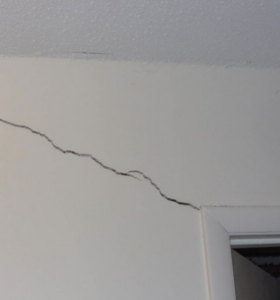
/
ABOUT THE CLAIM:
Recently, a Texas homeowner filed a property claim with his insurance carrier regarding cracks on his interior gypsum wallboards. His theory was that a leak in the sewer line beneath the home had disturbed the foundation, thus creating the cracks. He noted that the sewer line started in a central bathroom. Upon receiving notice of the claim, Guardian’s forensic engineer did a quick internet lookup of the 1990-build home and set out to visit the subject property.
ABOUT THE INVESTIGATION:
Accompanied by the insured homeowner, Guardian’s engineer completed a thorough inspection, both interior and exterior, of the 2800 sf, wood-framed, reinforced-concrete-slab-on-grade residence. He photographed and noted the locations of five exterior cracks, two points of frieze board separation, both with aged caulking, six interior cracks, one ceiling-to-wall separation and numerous hairline separations of the flooring in the hallway near the central bathroom. He also took pictures of proximal vegetation. Following the inspection, Guardian’s forensic expert performed a survey of the floor elevations utilizing a Technidea Ziplevel Pro 2000. He noted a maximum difference of .8 inches throughout the residence and observed no “dome” anywhere in the foundation.
ABOUT THE CAUSE & ORIGIN REPORT:
The cause & origin report discussed the soils and expansive clays often found in North Texas and the shrink-swell pressure that can disturb foundations. While underground leaks or sewer lines can also introduce excess moisture beneath foundations, this results in localized heaving that creates a dome in the foundation in the vicinity of the leak. No such dome was discovered in the bathroom leak area or elsewhere, so a sewer leak could be ruled out. To the contrary, the damages observed were consistent with differential settlement. This is due to variations in moisture content of the soils beneath the residence. The foundation did not extend below the expansive soils, which is done to prevent movement. Improper surface drainage adjacent to the foundation, as well as vegetation, contributed to the differential settlement. Additionally, parties were advised that the foundation may have been under-designed or improperly constructed, but that the damage observed was not severe and only further testing could confirm defects.
ABOUT GUARDIAN GROUP, INC.:
When property claims cross your desk, count on the forensic construction and engineering experts at Guardian Group, Inc. Providing carriers, TPAs, and adjusters rapid response, clear communication and definitive cause & origin reporting, Guardian Group’s Property & Casualty Group draws upon over 30 years’ complex claim investigations experience. When you need to know exactly what happened and why, put our reputation to work for you. Kindly call Guardian today.
